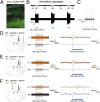Optogenetic neuronal stimulation promotes functional recovery after stroke
- PMID: 25136109
- PMCID: PMC4156770
- DOI: 10.1073/pnas.1404109111
Optogenetic neuronal stimulation promotes functional recovery after stroke
Abstract
Clinical and research efforts have focused on promoting functional recovery after stroke. Brain stimulation strategies are particularly promising because they allow direct manipulation of the target area's excitability. However, elucidating the cell type and mechanisms mediating recovery has been difficult because existing stimulation techniques nonspecifically target all cell types near the stimulated site. To circumvent these barriers, we used optogenetics to selectively activate neurons that express channelrhodopsin 2 and demonstrated that selective neuronal stimulations in the ipsilesional primary motor cortex (iM1) can promote functional recovery. Stroke mice that received repeated neuronal stimulations exhibited significant improvement in cerebral blood flow and the neurovascular coupling response, as well as increased expression of activity-dependent neurotrophins in the contralesional cortex, including brain-derived neurotrophic factor, nerve growth factor, and neurotrophin 3. Western analysis also indicated that stimulated mice exhibited a significant increase in the expression of a plasticity marker growth-associated protein 43. Moreover, iM1 neuronal stimulations promoted functional recovery, as stimulated stroke mice showed faster weight gain and performed significantly better in sensory-motor behavior tests. Interestingly, stimulations in normal nonstroke mice did not alter motor behavior or neurotrophin expression, suggesting that the prorecovery effect of selective neuronal stimulations is dependent on the poststroke environment. These results demonstrate that stimulation of neurons in the stroke hemisphere is sufficient to promote recovery.
Keywords: channelrhodopsin; stroke recovery.
Conflict of interest statement
The authors declare no conflict of interest.
Figures






References
-
- Carmichael ST. Plasticity of cortical projections after stroke. Neuroscientist. 2003;9(1):64–75. - PubMed
-
- Murphy TH, Corbett D. Plasticity during stroke recovery: From synapse to behaviour. Nat Rev Neurosci. 2009;10(12):861–872. - PubMed
-
- Nudo RJ. Postinfarct cortical plasticity and behavioral recovery. Stroke. 2007;38(2) Suppl:840–845. - PubMed
Publication types
MeSH terms
Substances
Grants and funding
LinkOut - more resources
Full Text Sources
Other Literature Sources

